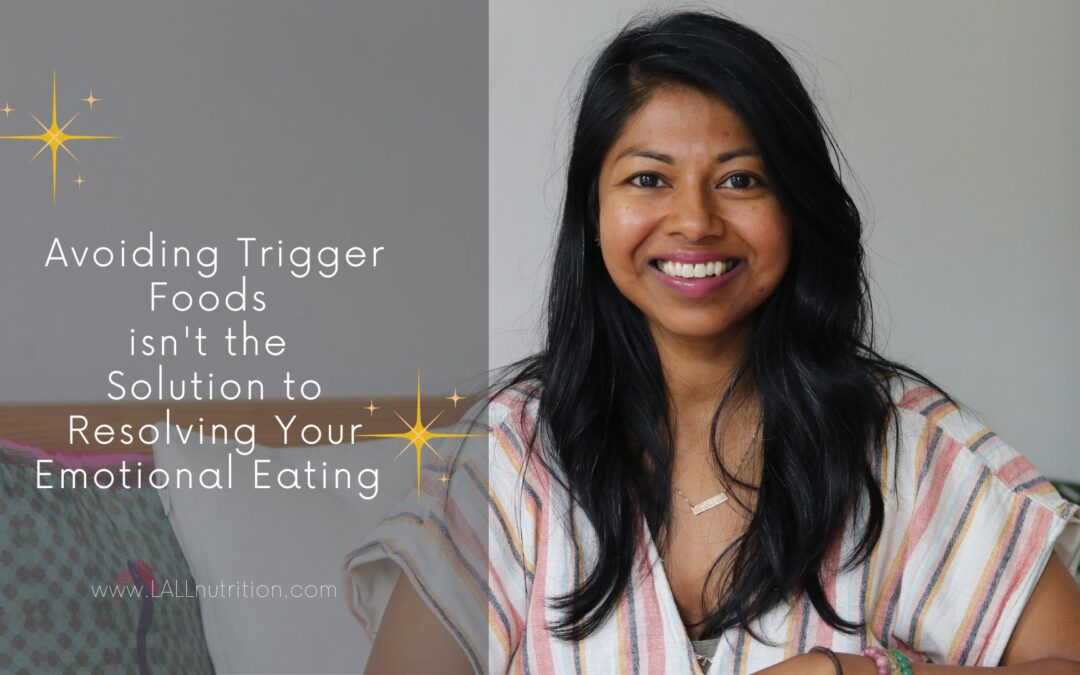Hello love,
I recently had a client tell me that the advice she was given about her emotional eating was to give up and avoid her trigger foods. Advice like this tells me that this person doesn’t quite understand emotional eating, the depth of it and what is creating this pattern for someone.
I want to share with you more about food, it’s role in emotional eating and what is really going on. Yes food plays a role but it’s not the whole picture.
Emotional eating is a coping mechanism/addictive pattern that we use to soothe ourselves form stress or any uncomfortable emotions. This pattern usually starts in childhood were certain needs were not met.
On my emotional eating journey, I thought I had to control the food but it is more than just the food even though it does play a role.
Why we go towards those foods?
The reason we go towards certain foods when we emotionally eat is because they give us a dopamine rush which makes us feel good temporarily. That’s why we’re using food.
Simply avoiding the food doesn’t work because it is not the food creating the pattern, it’s something deeper.
But when we do eat those foods (typically processed) that make us eat more and more and binge more and more is because 1) we are filling that void and 2) the food is not nutrient dense and that drives us to consume more.
So typically when you’re triggered into emotional eating you go towards more processed foods which give a bigger dopamine rush (I know you are not bingeing on broccoli!). This is a bandaid that takes the edge off of whatever was triggered.
Simply avoiding the foods is not the solution because it is not getting at what is going on under the surface.
So we can avoid those foods all we want but we then develop a restrictive mindset. This is why a lot of emotional eaters have a diet mentality. This only compounds the issue.
Restricting ourselves from these foods also make us crave them more because we can’t have them in our lives moderately.
And we haven’t found the root of the issue or resolved it.
Cutting out these foods is just a surface level solution.
So when I work with clients in The Emotional Eating Evolution Program we work through different phases to resolve their emotional eating because food plays a role, the body and emotions.
When you simply cut out something that seems to be the problem (ahem, a certain food) and not get into the root then you will still be using lots of willpower and that is draining.
There are 3 phases in the program ;true nourishment, body acceptance and emotional wellness.
Phase 1 – True Nourishment
Food is important because as we are nourished we can minimize the triggering foods, optimize digestion to improve mood, and discern true from emotional hunger.
Because we are moving away from restriction and improving mood we reduce some of the emotional eating triggers.
When we simply cut foods out that makes us psychologically feel deprived and want them more.
Phase 2 – Body Acceptance
In Body acceptance we honour our body’s rhythms and needs to help reduce emotional eating triggers. This helps to minimize mood imbalance which can trigger emotional eating.
Phase 3 – Emotional Wellness
Once we work through the 2 phases above we can get to the emotional triggers and the root of the emotional eating pattern in a deeper way.
I use somatic meditations with psychotherapy tools to get to the root of the pattern, clear it out and create a new way forward. This is done in an integrative way that is trauma informed.
This way of resolving emotional eating is very different than the conventional way. This is not about will powering your way out of emotional eating for the rest of your life. Once we address the emotional eating pattern at the roots we create sustainable change. Here you genuinely start feeling at ease, free and confident in your body and around food.
If you desire to feel free, confident and at ease around food and in your body and what I’ve shared resonates, I’d love to invite you to check out The Emotional Eating Evolution Program here to see how the program can support you in your journey to resolving emotional eating.
To nourishing yourself,
Michelle
Certified Holistic Nutritionist + Emotional Eating Guide


